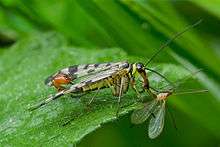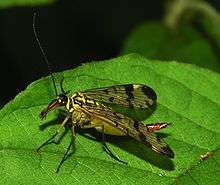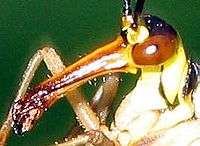Panorpa communis
| Panorpa communis | |
|---|---|
 | |
| P. communis male with prey | |
 | |
| P. communis female | |
| Scientific classification | |
| Kingdom: | Animalia |
| Clade: | Euarthropoda |
| Class: | Insecta |
| Order: | Mecoptera |
| Family: | Panorpidae |
| Genus: | Panorpa |
| Species: | P. communis |
| Binomial name | |
| Panorpa communis | |
Panorpa communis, the common scorpionfly,[1] is a species of scorpionfly.
Distribution
This species is native to Europe (mostly) and Northern Asia.[2][3][4]
Habitat
These scorpionflies can be usually found in hedgerows and patches of nettle. [5]
Description
Panorpa communis can reach a body length of about 30 millimetres (1.2 in).[5] The common scorpionfly has a black and yellow body, with a reddish head and tail. The male has a pair of claspers at the end of its tail (for holding the female during mating), [5] giving it a scorpion-like appearance, [5] although it is not a stinger.
The adult insect has a wingspan of about 35 millimetres (1.4 in),[5] with wings that are mostly clear, but have many dark spots or patches. Its head, mounted with large eyes, is drawn into a prominent, downward pointing beak, [5] which opens at the tip of its head.
In the female, the eighth abdominal segment is the shortest, almost twice shorter than the seventh; the sixth is narrowed towards the back. [6] The larva resembles a caterpillar and grows up to 20 millimetres (0.79 in) long. It has three pairs of thoracic legs and eight pairs of prolegs. [7]
Biology and habits
The adult is seen between May and September. [5] They eat dead insects (although they sometimes eat live aphids), sometimes taking them from spider webs[5] and plant sap.[8]
Although fully winged, the adults rarely fly very far and spend much of their time crawling on vegetation in damp, shaded places near water and along hedgerows. Panorpa communis is an univoltine species. [5] Eggs are laid in soil annually and the larvae both scavenge and pupate there. [5]
Gallery
 Mating (female on the right)
Mating (female on the right) Head detail
Head detail Wing detail
Wing detail Male genitalia
Male genitalia
References
- ↑ in Kendall Bioresearch
- ↑ Fauna europaea
- ↑ Catalogue of life
- ↑ Range at GBIF
- 1 2 3 4 5 6 7 8 9 10 UK Safari
- ↑ F. C. Fraser: Handbooks for the identification of British Insects. Vol. I. part 12 and 13. Mecoptera, Megaloptera, Neuroptera. Londyn: Royal Entomological Society of London, 1959, s. 8–10
- ↑ Strange animals
- ↑ "food" in uksafari.com
External links
- Peter Holden, Geoffrey Abbott RSPB Handbook of Garden Wildlife
- Bloomsbury Concise Garden Wildlife Guide
